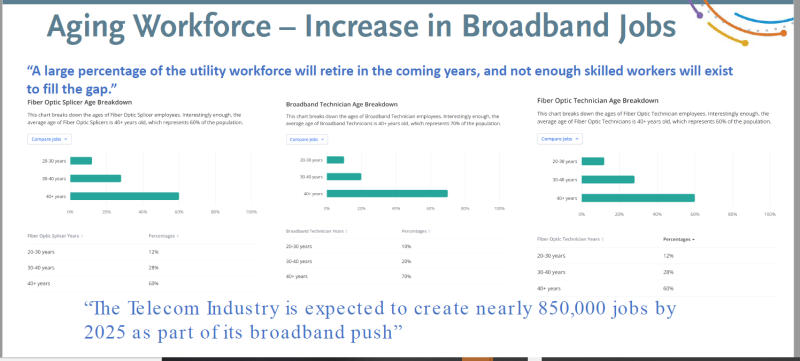As an aging workforce and a lack of interest among young people threaten to derail nationwide broadband access efforts, the industry’s stakeholders must come together to face what has become a massive fiber skills gap, said Deborah Kish, VP of workforce development at the Fiber Broadband Association (FBA).
The Government Accountability Office estimated that around 34,000 workers might be needed this year to support the government’s broadband expansion programs, depending on unpredictable project timelines.
And the workforce shortage is in many ways a legacy the industry left itself, Kish said.
“We have not as an industry done a good job at all of keeping this occupation in the limelight for young people,” she told Fierce. “Fiber is about 35-40 years old, so anybody who got into it in the beginning is likely still working.”
Kish sees industry veterans and seasoned professionals as a potential asset in establishing fiber training programs across the country and suggested that the industry will “need to do a call to retirees to get people to train.”
But even if the industry had sufficient training resources in place (it doesn’t), the interest to work in the industry is just not there among young people. The FBA found that workers between the ages of 20 and 30 only account for 12% of the industry’s fiber optic technicians.

Without a pipeline of new people to come in, and the population's current workers on their way out, the industry is seeing a “humongous gap,” Kish said.
“I think we lost to four-year college degrees. We lost to writing code and building apps and things like that,” she added. “Technology took us in a different direction where young people are more interested in building an app or whatever and making a million dollars on that kind of thing.”
Contrary to what some might expect, jobs in fiber actually pay quite well.
As of May 2023, the average annual pay for a fiber optics technician in the U.S. was around $60,000, according to ZipRecruiter, and annual salaries can reach nearly $200,000.
“I think there's also a perception of this being a dead-end job, and I've often said that I think that the telecommunications industry is the best kept secret in terms of career building. It's endless,” Kish said.
‘It takes a village to build a broadband workforce’
The FBA is focusing on community colleges, veteran programs, departments of corrections and at risk youth programs across the country, as well as working with the service provider community, to set up the training infrastructure and workforce pipeline the industry needs.
“Send a school a fiber kit, for example. Let them know what's out there as a potential for maybe a kid who isn't getting pushed into a four-year college degree, or doesn't know what they want to do yet,” Kish said.
Much of the funding coming in from the Broadband, Equity, Access and Deployment (BEAD) program and the Infrastructure Investment and Jobs Act (IIJA) has been slated to go to building.
“Materials and things like that, but you can't build a network if you haven't built a workforce,” Kish added. “It's chicken and egg, cart and horse, however you want to put it. I am hoping that those who get the money do in fact put it toward workforce development.”
The FBA issued its own Broadband Workforce Development Guidebook, which gives local stakeholders like state broadband offices direction in setting up their own training programs.
The association also developed a fiber optic training program to help stakeholders with the fact that there “currently is no trusted credential in the market right now,” Kish said. “There's lots of different fiber optic tech training but they tend to be short, a week or less, and they are not as in depth or have the hands-on skills training that our members have found to be sufficient.”
The program covers skills including installation, splicing and maintenance of fiber.
Providers need to do their part as well and provide clarity on the specific number of workers needed for upcoming projects. “Everybody is chasing this number, how many jobs is this,” Kish said. “Across the entire telco industry, there will be a need for much more than at-home installers.”
As companies continue building out networks and gaining subscribers, they will need more people to work in network operation centers, customer service operations, maintenance crews – and that list goes on and on, according to Kish.
“They need to know how many miles of fiber they're building, how many homes they want to connect, all the areas that they want to go in and figure out how many people they're going to need, but they're going to need a place to get the training,” Kish said.
And it can't all be on the job, she added, because on-the-job training “leads to shoddy workmanship and workarounds that we don't need anymore. So what we're trying to get to is a standardized training program to avoid those things that have happened in the past.”
This will take a combined effort across service providers, vendors and even guidance counselors in high schools.
“It’s the whole entire ecosystem. It takes a village to build a broadband workforce,” Kish said.
